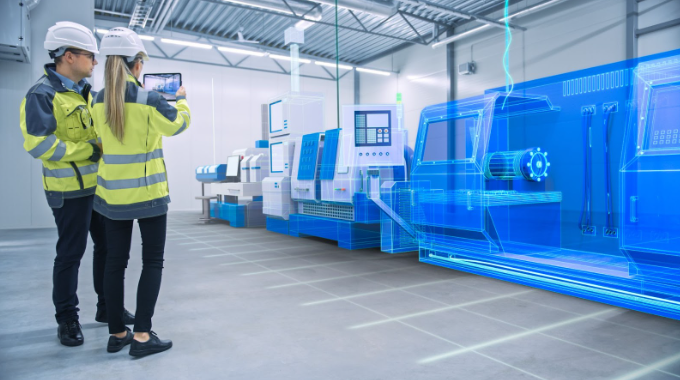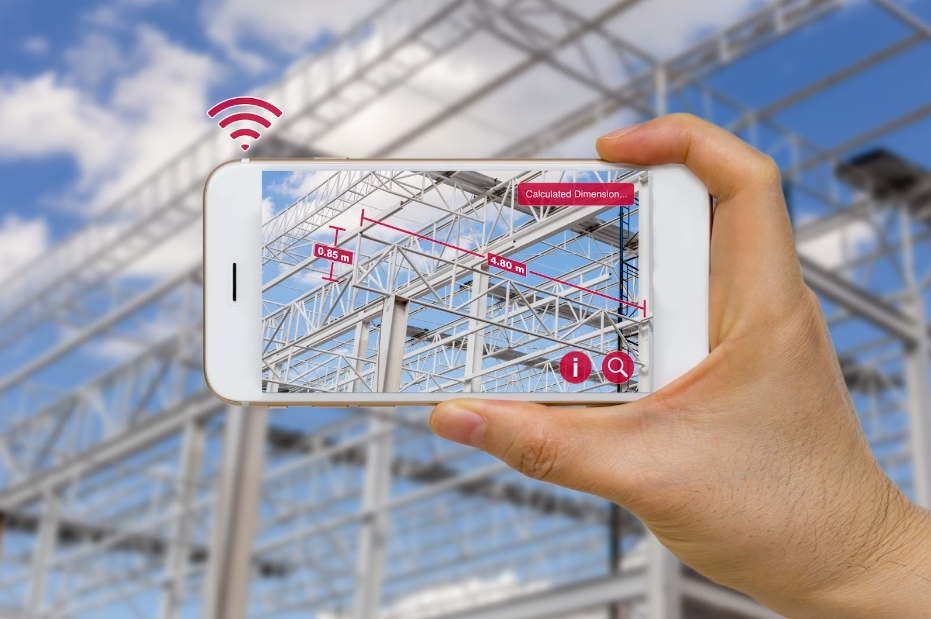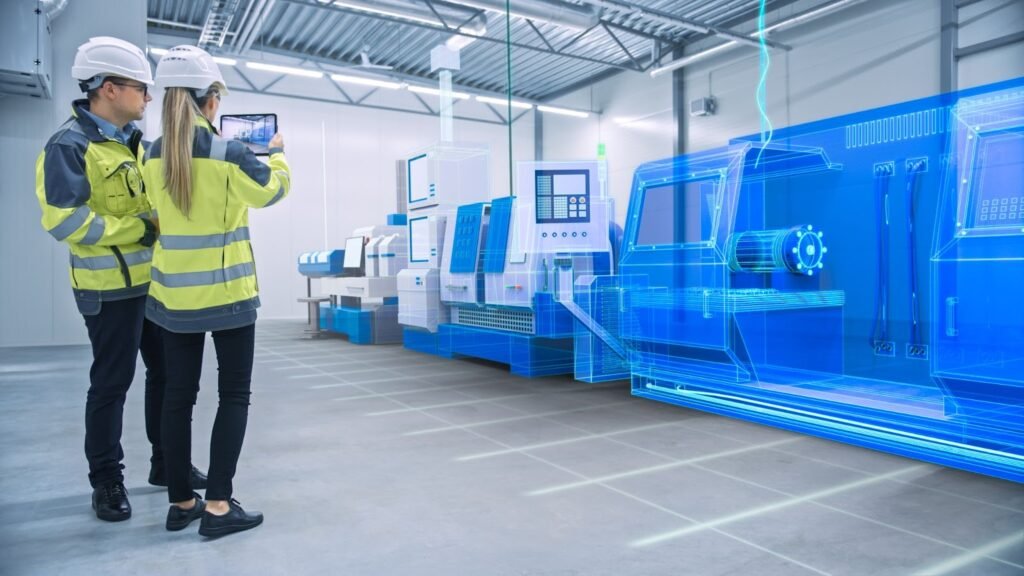The construction industry is rapidly evolving, and augmented reality (AR) plays a pivotal role. If you’re an AEC professional without exposure to augmented reality, you may have questions about its benefits and applications.
This article dives into using augmented reality in construction management while examining its advantages and challenges.
What is augmented reality?
Augmented reality brings together the real world and the digital world. Using computer-generated content, augmented reality provides text, graphics, and audio that digitally represent a real-world space or object.
Augmented reality is different from virtual reality because it uses current or live information and integrates this data with real-world objects. Rather than existing in a separate realm, augmented reality adds virtual elements into the real-world environment for a unique experience.
The AR market is growing rapidly, and many brands are taking notice. You’ve probably seen the application of AR in different fields.

Pokemon GO is one of the biggest examples of augmented or mixed reality. The popular game allows players to catch virtual Pokemon in the real world. Through GPS integration, the app detects where users are and supplies various Pokemon to catch based on the individual’s location.
Additional AR case studies in other industries include:
- Adidas’ iOS app allows users to see what shoes look like on their feet before purchasing online.
- Acura’s AR racing game lets users test various car models while simulating the Acura driving experience.
- IKEA’s virtual boutique places IKEA furniture inside the user’s home to see what it would look like.
One of the greatest benefits of augmented reality is that it highlights specific features and elements to provide real-world applications. Construction companies can use this data to test specific solutions and products to gauge how successful they may (or may not) be if brought to market.
How is augmented reality used in construction?
Augmented reality has the power to enhance visualization, planning, and communication in construction projects. Architects, engineers, and construction professionals can overlay digital models and information onto a real-world environment to enable real-time collaboration, improved clash detection, and accurate on-site measurements.
It also lets stakeholders do virtual walkthroughs of construction sites before things are built so everyone can easily weigh in on the plans. Project managers might either wear AR goggles or hold up an iPad up to see a construction plan’s virtual elements in live space.
Team members can use the virtual model throughout construction to ensure plans develop as expected and issues don’t pop up. They can compare what’s happening in the physical realm with what project simulations dictate should take place. Once the project is complete, they can use augmented reality to double-check if they meet all requirements.
3 ways augmented reality is revolutionizing construction
Below are several examples of how augmented reality is changing the future of construction. As you read through these examples, consider the potential impact of each advantage on your own business or projects.
- On-site coordination. When things don’t fit according to the building plan, contractors often have to make decisions on-site, which can already pose a challenge to project workflows. Using augmented reality technology wearables — like an AR headset or mobile device — to visualize a potential design prior to installation can help a project manager make smarter changes on the fly and keep rework to a minimum. AR technology can also help contractors better engage with architects and engineers when they have questions or run into issues.
- Logistics planning. AR can also help with project planning by streamlining logistics. One use case might include field workers using AR to visualize where to store materials on-site. This would be helpful on tight construction sites where there doesn’t seem to be room to fit it all. AR can help them better plan out how they use their space by determining when materials should get delivered and where they should go when they arrive.
- Installation support. Augmented reality can also be used to improve the installation process by projecting images or digital information onto a real-world environment. This visualization allows workers to accurately position and align construction components according to the dimensions of a physical space using real-time guidance and visual cues.
Challenges of augmented reality in construction projects
Because there are so many advantages to using augmented reality during the construction process, you may wonder why everyone isn’t choosing to implement it. However, there are a few challenges or limits you may experience when trying to improve your workflows with augmented reality. Here are a few of the top reasons it might pose a problem for your construction projects:
- Acceptance. Augmented reality is still a new technology that lacks sufficient testing and application. Some may still have doubts about its usefulness or credibility, fostering skepticism or lack of trust among project stakeholders. AR’s limited track record could also lead some to question its usefulness or credibility, resulting in resistance to adopting AR-based solutions or relying on AR for critical decision-making. To overcome this, educate your stakeholders to showcase the benefits and reliability of AR in construction. Addressing their concerns and giving them evidence of its successful applications can help build confidence and encourage wider acceptance of AR in the industry.
- Accessibility. Using augmented reality requires a strong internet connection. Without on-site internet access, there’s no guarantee that your tools will work effectively. This can be an issue in remote locations where internet access is unreliable. One way to use AR in these situations is with offline AR applications. Real-time collaboration may require a stable internet connection, but some augmented reality tasks can be done without one. By preloading necessary data and resources onto local devices or using offline caching techniques, construction workers can still benefit from some AR functionalities in remote areas.
- Consistency. As with any emerging technology, there may be hardware limitations and environmental conditions to consider that can impact the accuracy and consistency of AR systems. However, as time goes on and this technology continues to advance, AR applications should continue to improve.
One potential solution to this is investing in AR research and development efforts. With thorough testing, user feedback, and refined algorithms, AR developers can work towards enhancing AR systems’ accuracy and consistency for future projects. Additionally, promoting open dialogue and knowledge sharing within the industry can help foster learning and drive AR technology improvements.
- Financial application. Because the financial impact of the use of augmented reality is still relatively unclear, some construction companies and stakeholders may hesitate to fully adopt the technology. Once more case studies are available which demonstrate the financial viability and return on investment (ROI) of using AR for construction, this should become less of an issue.
- Learning curve. As a new form of technology, project leaders and stakeholders must set aside time to learn how to use the new technology. This is both a time and financial investment, which can cause further financial concerns like those mentioned above.
Learn how RevitGods can help your next BIM project become a success
Augmented reality is having a sizable impact on professional construction, but using an accurate 3D BIM model that can integrate with any AR platform will streamline your project even more. Want to know how to create accurate digital twins of your projects, or need help running BIM coordination? We’re here to help.
To fully unlock the power of BIM implementation, contact RevitGods to handle your BIM management throughout the next project life cycle. We can help you save time, energy, and money throughout each step of the design process.
If you have a question about BIM, connect with one of our RevitGod’s experts. We’re ready and equipped to handle a wide range of questions on BIM implementation, Revit, industry standards, and other related topics.




